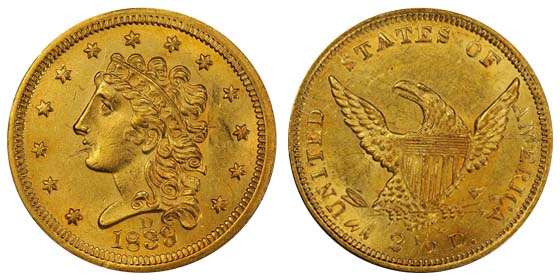Classic Head Quarter Eagle Values
How Much Classic Head Quarter Eagles are Worth: Classic Head Quarter Eagle Values & Coin Price Chart

Year | Mint | Variety | Designation | VG-8 | F-12 | VF-20 | EF-40 | AU-50 | U-60 | MS-63 | MS-64 | MS-65 | MS-66 | MS-67 |
|---|---|---|---|---|---|---|---|---|---|---|---|---|---|---|
1800 | P | Plain 4- Stemless Wreath | Red-brown | 200 | 300 | 400 | 500 | 600 | 700 | 800 | 900 | 1000 | 1200 | 1100 |
| Year | Mint | Variety | Designation | VG-8 | F-12 | VF-20 | EF-40 | AU-50 | MS-60 | MS-63 | MS-64 | MS-65 | MS-66 |
|---|---|---|---|---|---|---|---|---|---|---|---|---|---|
| 1834 | (None) Phil | -- | -- | $556 | $703 | $780 | $1,040 | $1,278 | $3,180 | $8,740 | $15,610 | $50,900 | $100,000 |
| 1835 | (None) Phil | -- | -- | $556 | $703 | $780 | $1,040 | $1,305 | $3,540 | $11,475 | $24,350 | $57,250 | -- |
| 1836 | (None) Phil | -- | -- | $556 | $703 | $780 | $1,040 | $1,278 | $3,180 | $8,740 | $15,610 | $50,900 | -- |
| 1836 | (None) Phil | Script 8 | -- | $556 | $703 | $780 | $1,040 | $1,395 | $3,180 | $8,740 | $15,610 | $54,750 | $91,250 |
| 1837 | (None) Phil | -- | -- | $653 | $755 | $885 | $1,328 | $1,949 | $5,310 | $13,000 | $34,520 | $67,750 | -- |
| 1838 | (None) Phil | -- | -- | $556 | $730 | $808 | $1,068 | $1,770 | $3,763 | $11,425 | $16,050 | $50,900 | $80,250 |
| 1838 | C | -- | -- | -- | $4,840 | $6,140 | $8,960 | $11,750 | $37,350 | $75,500 | $124,500 | -- | -- |
| 1839 | (None) Phil | -- | -- | $900 | $990 | $1,225 | $2,240 | $3,845 | $14,100 | $56,700 | -- | -- | -- |
| 1839 | C | -- | -- | -- | $3,760 | $5,170 | $7,630 | $9,400 | $29,600 | $84,100 | -- | -- | -- |
| 1839 | D | -- | -- | $3,760 | $4,480 | $5,780 | $8,130 | $11,200 | $36,500 | $88,500 | $167,300 | -- | -- |
| 1839 | O | -- | -- | $1,500 | $1,563 | $2,185 | $4,065 | $5,975 | $15,350 | $43,995 | $86,300 | $143,250 | -- |
Description and History
Historical Context
The Classic Head Quarter Eagle emerged during a pivotal era in U.S. history when the young nation was expanding westward, and its economy was evolving rapidly. The coin was introduced as part of a broader effort to stabilize the country’s gold coinage, which had been in flux due to the fluctuating value of gold. This period saw significant changes in the Mint’s approach to coin design and production, influenced by legislation such as the Coinage Act of 1834, which reduced the gold content in coins to align with their face value and international exchange rates.Design and Designer
William Kneass, serving as the Chief Engraver of the Mint from 1824 until his death in 1840, was instrumental in developing early American coinage designs. The Classic Head Quarter Eagle represented a departure from previous designs, featuring a left-facing portrait of Liberty wearing a fillet inscribed with the word “LIBERTY.” This innovative design choice reflected the era’s neoclassical aesthetic preferences. The coin’s reverse displays an eagle with outstretched wings, clutching arrows, and an olive branch, encapsulating the young nation’s values of peace and readiness.Mintage and Varieties
Over its six-year production run, the Classic Head Quarter Eagle saw several changes in its design and minting process, leading to a variety of subtypes that are of particular interest to collectors. Notably, the coin was minted at different locations, including Philadelphia (no mint mark), Charlotte (C), Dahlonega (D), and New Orleans (O), with the mint mark located on the reverse below the eagle. These variations and year-to-year changes in minting figures add to the coin’s appeal and rarity. Mintage figures varied significantly yearly, with some years producing far fewer coins than others. For example, the 1839-C and 1839-D issues are particularly rare, with meager mintage numbers, making them highly sought after by collectors. The exact mintage numbers for each year and mint can provide valuable insight into the coin’s rarity and potential value.Value and Collectibility
The value of a Classic Head Quarter Eagle is influenced by several factors, including rarity, condition, and historical significance. Coins in higher states of preservation (graded using the Sheldon coin grading scale) are especially prized by collectors and investors. The presence of original luster, minimal wear, and sharpness of detail are critical in determining a coin’s grade and, consequently, its market value.The historical context and the artistic merit of Kneass’s design make the Classic Head Quarter Eagle a fascinating subject for collectors. Its significance goes beyond mere monetary value, offering insights into the economic and aesthetic shifts of early 19th-century America. For investors, these coins represent a tangible connection to the past and a potentially lucrative addition to their portfolios, given their rarity and the ongoing interest in pre-1933 U.S. gold coins.
The Classic Head Quarter Eagle is more than just a piece of currency; it is a piece of American history.
Its design reflects the nation’s early struggles and successes, while its varied mintage offers a window into the economic and technological developments of the time. For collectors and investors, the Classic Head Quarter Eagle is a prized asset, offering the joy of ownership and the potential for appreciation. Whether for its historical significance, aesthetic appeal, or investment value, the Classic Head Quarter Eagle remains a cornerstone of American numismatic collections.
